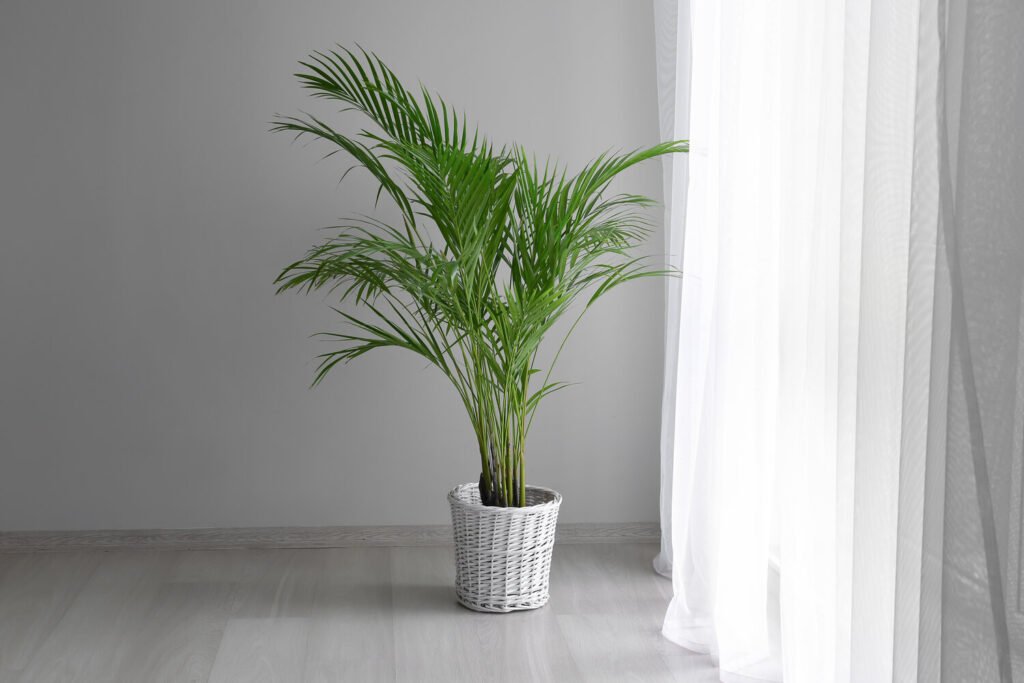Did you know that there are 100 species of areca palms all over the world?
I know there are many different types of houseplants to bring home but if you are looking for a blending of aesthetically pleasing and functional, then areca palm is the perfect choice for you. It is one of the most resilient plants for both indoor and outdoor environments.
Several varieties of species of Dypsis are there but don’t you worry, as I will be talking about only the most popular ones. Also, if you are a beginner, I will guide you to know everything about areca palms with my personal experience over the years. So, let’s begin with the common name of areca palm that you should know about!
What Is The Areca Palm’s Common Name?

The Areca Palm, also known as the Chrysalidocarpus lutescens and Dypsis lutescens in botanical terms, is also known as the Butterfly Palm, Bamboo Palm, Golden Butterfly Palm, Cane Palm, Yellow Palm, and Golden Feather Palm. These are a few common names that most people use.
Now, you know the common names of this plant, but how can you recognize an areca palm as there are so many different varieties? Also, did you know that the areca palm and bamboo plant are so similar that the areca is also known as a bamboo palm? Let us explore these interesting facts below!
How can you recognize an Areca palm?

Many varieties of young palms look similar, so it can be difficult for you to determine the right one.
As a result, at first glance, you can mistakenly think that your palm is an Areca or vice versa. If you are familiar with the rules of inspection and identification, it will be easy for you to determine the right Areca palm from any other palms.
Let us go through some identifying guidelines that I have given below!
- Pay great attention to the plant since Areca palms have erect, symmetrical leaves that float above the plant.
- The standard for Areca palm leaflets is 17 inches in width and 2 feet in length.
- Both sides of its leaves are a deep green hue.
- An Areca palm must be present if the plant has a cluster of yellow-green stems.
- Areca palm tree kinds grown inside can exceed their container in a few years with yearly growth of 6–10 inches.
Areca palms and bamboo palms look very similar. How can we distinguish between the two?
Yes, bamboo and Areca palms are the same. It has similar characteristics to bamboo, such as poor light tolerance and delicate fronds, which is how it got its name.
Additionally, the majority of Areca palm variants have a golden or yellowish-green trunk that resembles clusters of bamboo. It has broad, thin fronds that resemble bamboo leaves in appearance which is why the areca palm is also known as a bamboo palm.
Several varieties of Areca palm that you must know!
There are several types of Areca palm trees. I will talk about a couple of the most popular Areca plant varieties that you should know. So let’s get started and discuss each of these Areca palm kinds one by one.
1. Dypsis decaryi
This Areca palm is native to Madagascar and is very stunning and very popular. It is a small to medium-sized palm with a single trunk and a three-tiered crown of feathery, keeled, bluish-green leaves perched on top.
Given its triangular-shaped leaves that grow from three separate spots where the fronds emerge, it is sometimes referred to as the Triangle palm.
2. Dypsis baronii
These palm trees kinds are suitable for people who have small gardens or less space for gardening. The smaller palms will give the field more personality so that you can even incorporate them in an area with plenty of big palms. It can be planted in a container with well-drained soil because it grows slowly.
Although they like partial shade to full light, these types are often planted inside. Strong winds should be avoided since they might seriously harm the palm fronds. It has enormous but delicate fronds. The palm will reach a height and width of roughly three meters.
3. Dypsis utilis
This species is one of the evergreen ones that can reach a height of 15 meters. The clumping palm may produce many stems. Unlike the majority of other Areca plant varieties, this one may sprout three side shoots that develop in tandem with the main stem.
Large leaves cover every stem, forming a crown around it. It is a very useful type with many applications and health advantages, and the palm is collected for food, medicine, and as a source of fiber. Additionally, it is a very popular variety among plant enthusiasts.
4. Dypsis prestoniana
It is a gigantic and very aesthetic palm that is very unique and uncommon. It may be found primarily in eastern and southern Madagascar because, in those places, the temperature is just right for the palm to flourish. The plant primarily thrives in damp woodlands around mid-elevation.
This palm produces a 40-foot-tall, 16-inch-diameter, ringed, sturdy trunk. The leaves have no crown shafts, as is typical with most other palms, and are white at the base. The palm thrives well in subtropical, tropical, and temperate climates.
5. Dypsis lanceolata
This species is one of the most uncommon and little-known which is indigenous to the Comoro Islands and resembles the Dypsis cabadae in appearance, although it is much more attractive. Typically, people use it as a decorative palm in their homes or offices.
Furthermore, the palm only grows in bunches to a height of 20 feet and has extremely broad leaflets. This may be a great addition to smaller, warmer-climate plants like tropical or warm-climate gardens.
6. Dypsis special
This species previously went by the name Dypsis pilulifera, but now it requires a new name because it is quite distinct from that species. The elder leaves fall, revealing a superb decorative big palm with a vivid, orange-hued crown shaft. It is also a cold-hardy palm that can flourish in temperate climates.
7. The dark mealy bug
The stunning and seductive Dypsis sp. ‘Dark MealyBug’ is the final Areca palm variety on our list. It is a rare and enigmatic palm that is normally found in north-eastern Madagascar’s Masoala peninsula.
It is a beautiful and colorful palm that is typical of lowland rainforests and has reddish-brown leaf midribs with darkening patterns. Additionally, the attractiveness of the plant is enhanced by its pendulous leaflets, dark green leaves, white stem, and crown shaft.
Now, you know the varieties of areca palm species, but do you know the height that an areca palm can reach? Is areca palm safe to keep in your house? Let us now discuss these doubts that are revolving in your mind!
What Height Do Areca Palms Reach?
Most Areca palms will typically range in height from 10 to 30 feet and in width from around 15 feet. They have become so popular because of their tolerant, low-maintenance temperament, and lofty size. Every type of Areca palm is unique, yet they all tend to grow quite tall.

Is Areca Palm Safe for Your Home?
Yes, they are safe for your home. Areca palms make ideal house plants since they have a lot of advantages which we will discuss now!
1. They can reduce your stress levels and increase the air’s humidity. Many plants are capable of that qualities, it is their ability to generate a feeling of relaxation and comfort in the house that they are in. Houseplants have been shown to help decrease stress by letting people feel more relaxed, quiet, settled, and unaffected in indoor environments. Areca palm is no different from them. The mental aspect of gardening and taking care of something from scratch has been shown to reduce your heartbeat and bring ease and peace.
These plants do not require a ton of water, water might even damage them. So, to control themselves from being exposed to too much water, areca palms usually remove moisture through their palm fronds. So, If you are residing in a dry area, areca palms are known to be great and natural to raise the humidity of the air inside a dry house.
2. They require little upkeep. The primary considerations for growing and nurturing areca palms are ensuring that your plant has sufficient moisture but is potted in a container and that soil quickly drains but keeps containing some moisture. The plant does not need any kind of transplanting for 2 or 3 years overall, adding to the comfort of the plant owner.
3. They lessen airborne impurities. A research shown by NASA on clear air confirms that areca palms easily emit airborne toxins containing formaldehyde, xylene, and toluene from the atmosphere, all of which are infamously known to affect your lungs.
4. They are not poisonous. It’s difficult to find an indoor plant that is easy to maintain and secure from pets at the same time, fortunately, areca palm is one of those plants backed by ASPCA (American Society for the Prevention of Cruelty to Animals) as a pet-friendly plant. So, your precious furry and green friend both can live under the exact roof without any hesitation.
5. They increase the amount of oxygen in the air around you. The genuine method of photosynthesis dictates that plants engross carbon dioxide and excel out oxygen during the day. So, normally, all living houseplants restock the oxygen in your indoor air.
6. They enhance the aesthetic appeal and are Feng Shui plants. With its delicate and full palm leaves, the areca palm happens to be one of the finest specimens of a good feng shui plant.
FAQ’s
Q1. Is Areca Palm Maintenance Expensive?
Ans. One of the easiest to care for plants is Areca palms. They don’t require much more than full sunshine for at least 4-6 hours a day and well-draining soil.
Q2. How Much Do Areca Palms Cost?
Ans. If you look for an Areca palm that is fully matured, it may be rather pricey. This explains why most people choose little tabletop Arecas.
Q3. What Does the Areca Palm Symbolise?
Ans. The Areca palm is a representation of all that is good. It is seen as a representation of recompense, honor, truth, liberation, victory, triumph, a joyful return after a journey, endless life, and growth.
Q4. Is there evidence that Areca palms attract rats?
Ans. Rats and other rodents frequently find shelter in palm trees. So, sure, they do draw rats, but you can get rid of them by taking away their food.
Conclusion
I know there are hundreds of species to choose from, but before choosing a species, you should first check on the benefits and functionality. First, determine the functionality and then determine the characteristics. I am sure with our given guidance above, choosing an areca palm will now be less difficult for you.
I hope this article helped you, and if you have any further questions about areca palm, feel free to comment down below, and don’t forget to share this article with your friends and family!
Related Articles
- Areca Palm Dying: Why and How to Save It
- Spots On Areca Palm (White, Brown, Yellow, and Black) – Causes and How to Fix Them
- Areca Palm Leaves Turning Brown: Causes And How To Fix The Browning Leaves
- Parlor Palm vs Areca Palm: Differences You Should Know
- Areca Palm Leaves Turning Yellow: Causes and How to Fix Yellowing Leaves
- Areca Palm Diseases and Pests: Causes and How to Fix Them







